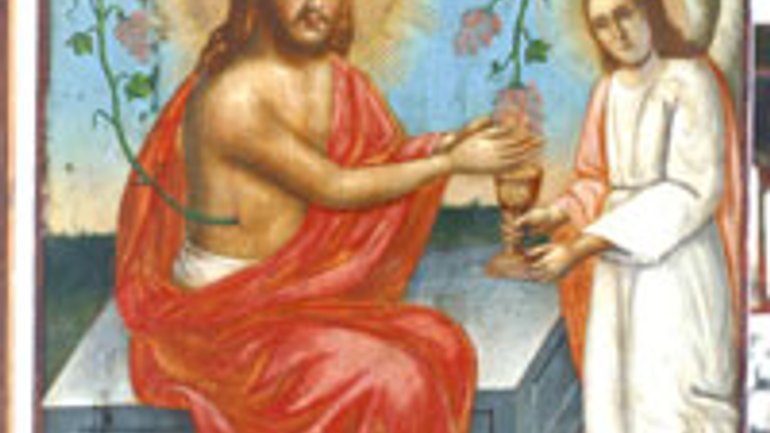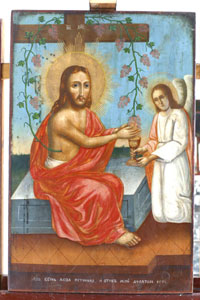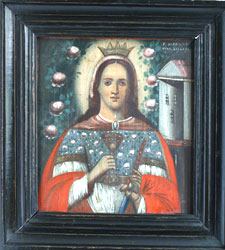500 Folk Icons from a Private Collection

It took 12 years for Mykola Babak, a painter, writer and collector from central Ukrainian Cherkasy to gather, at his own expense, a unique 500-item collection of Ukrainian folk icons of the central Dnieper region of the 17th to19th centuries. The painter recently transferred the collection to the Cherkasy Art Museum for a permanent exhibit.
 Mykola, you could collect anything. Why Ukrainian folk icons?
Mykola, you could collect anything. Why Ukrainian folk icons?
In the beginning, I had a few dozen icons, which were aesthetical amusement for me as a painter. Only after visiting the central Warsaw market in 1991, where for hundreds of meters our Ukrainian icons are displayed for sale, did I start to collect them, so that the best models of Ukrainian painting would remain in Ukraine. For the future of this unique cultural phenomenon is important for us, and especially our future generations, and not for the Poles.
In the beginning, my collecting was not systematic. Later, I realized it should be a collection of icons of our native land, central Ukraine.
What is unique about the collection?
It is a collection of Ukrainian home icons of the central Dnieper region of the 17th to 19th centuries. This alone makes it unique. It is a kind of Ukrainian art which never existed and will never exist in any other culture of the world.
At that time, there was an iconostasis in every Ukrainian house. However, an ordinary peasant could not afford an icon painted by a monk. So icons were painted by ordinary painters, who transformed canonical images into folk ones and gave them features of their relatives and fellow villagers. They often also added folklore-aesthetic elements, elements of Ukrainian floral decoration, which brought joy and beauty to the Ukrainian soul.
In many icons, the Mother of God looks like an ordinary woman, the great martyrs Barbara, Paraskeva and Catherine look like beautiful, round-faced Ukrainian girls, and Nicholas is depicted as a wise, presentable man. It is due to this closeness of the images of saints to Ukrainian life that the Ukrainian folk icon ranks high in the art world.  Mykola Panteleimonovych, how did you choose the items for your collection?
Mykola Panteleimonovych, how did you choose the items for your collection?
I visited villages, district centers, bought icons in antique shops. Icons were also brought by people who knew about my hobby. But my most valuable achievement was the exchange of my collection of Ukrainian folk art for icons of the central Dnieper region from the collection of Volodymyr Bilandzher, a collector from Kyiv. The collection became systematic and fundamental exactly from that moment.
Your hobby is obviously quite expensive. Did anyone give you financial support?
The whole collection has been gathered and restored at my own expense. I spent all the profit from the sales of my paintings and literary works on the collection.
The collection requires not only considerable financial spending, but also persistent work. An item needs not just to be found but also restored. Day after day for 12 years, I was busy with restoration work. I was assisted by Victor Kriuchkov, a painter-restorer, only in the most difficult cases.
Mykola, were there any offers to buy the collection? And, if it is not a secret, how much did they offer?
Of course, there are interested persons. They offer fantastic money for the collection today. I will never sell it. First of all, it is invaluable, and, by the highest standards, a collection of that caliber cannot belong to one person. And secondly, icons were never to be sold. Even when a house was left empty and the owners’ relatives did not want to take the icons, the owners gave them away or simply buried them, like human beings.
I transferred the collection to the Cherkasy Art Museum for a permanent exhibit so that my contemporaries could come and esteem these genuine holy works, created by our great ancestors. For these will never be created again either in Ukraine or any other country.
What is an icon, and your collection, for you: art or spirituality?
For me, icons and my collection are my love. My mother’s death impoverished me… I associate all these holy images with her and feel her love through them.
At difficult moments in my life, I try to be near the icons, the holy images. It is a very powerful bio-field, some mysterious power. And after a few hours, I am ready not only to work and live, but to create!









